International Employment Relations: A Comparative Analysis
VerifiedAdded on 2019/10/30
|8
|2202
|135
Report
AI Summary
This report provides a comparative analysis of international employment relations, focusing on the human resource systems, values, and remuneration practices in the USA, China, and Canada. The introduction highlights the importance of managing a diverse workforce and the significance of understanding cultural differences. The report delves into the human resource systems, examining selection criteria, training and development expenditure, and the emphasis on employee satisfaction. It then explores employment relations, discussing how these differ in the three countries. The report also investigates the values held by employees and organizations, highlighting cultural nuances and their impact on workplace dynamics. Finally, it examines remuneration systems, comparing compensation practices and incentive schemes in each country. The report concludes by emphasizing the role of managers in navigating these complexities to achieve organizational goals.
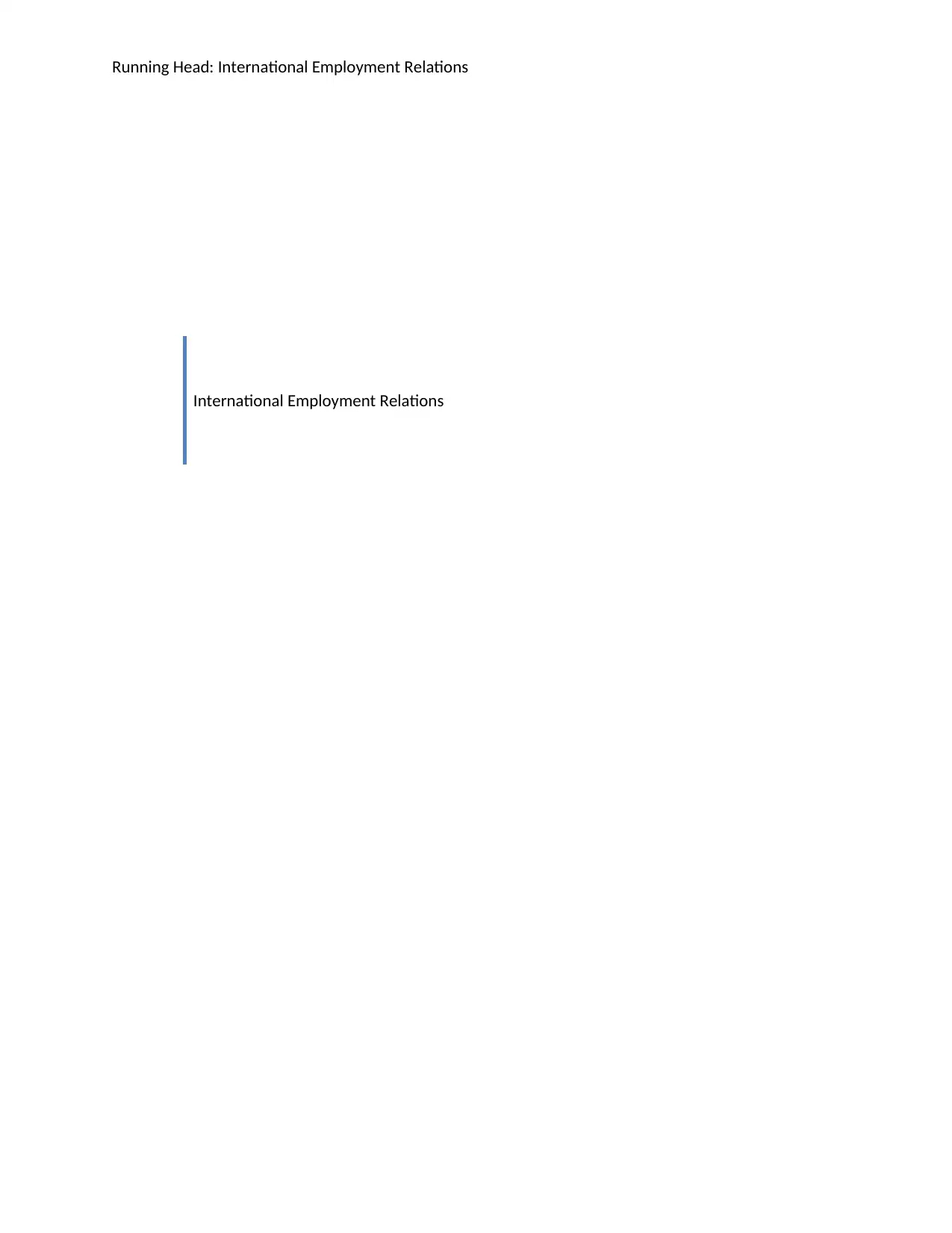
Running Head: International Employment Relations
International Employment Relations
International Employment Relations
Paraphrase This Document
Need a fresh take? Get an instant paraphrase of this document with our AI Paraphraser
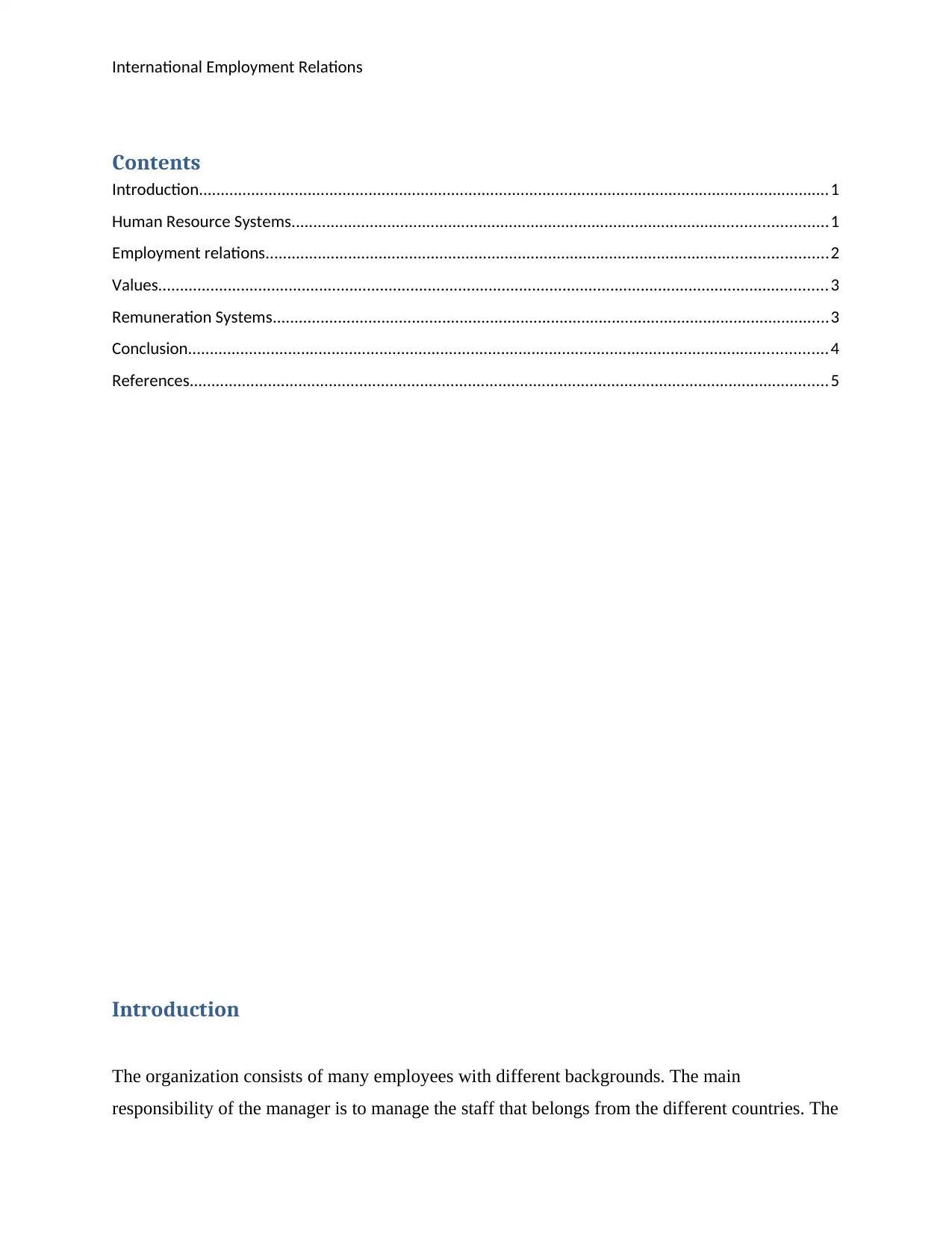
International Employment Relations
Contents
Introduction.................................................................................................................................................1
Human Resource Systems...........................................................................................................................1
Employment relations.................................................................................................................................2
Values..........................................................................................................................................................3
Remuneration Systems................................................................................................................................3
Conclusion...................................................................................................................................................4
References...................................................................................................................................................5
Introduction
The organization consists of many employees with different backgrounds. The main
responsibility of the manager is to manage the staff that belongs from the different countries. The
Contents
Introduction.................................................................................................................................................1
Human Resource Systems...........................................................................................................................1
Employment relations.................................................................................................................................2
Values..........................................................................................................................................................3
Remuneration Systems................................................................................................................................3
Conclusion...................................................................................................................................................4
References...................................................................................................................................................5
Introduction
The organization consists of many employees with different backgrounds. The main
responsibility of the manager is to manage the staff that belongs from the different countries. The
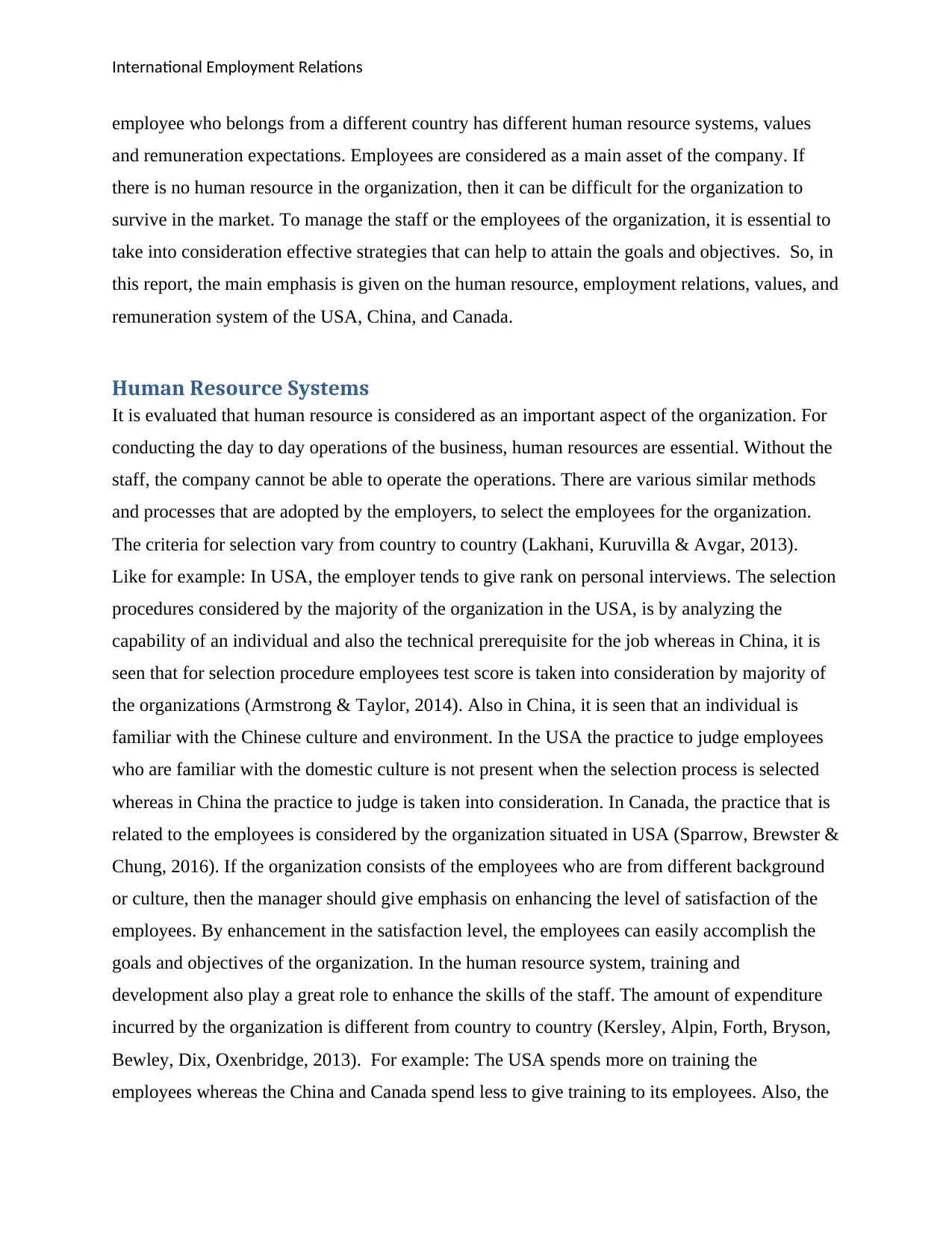
International Employment Relations
employee who belongs from a different country has different human resource systems, values
and remuneration expectations. Employees are considered as a main asset of the company. If
there is no human resource in the organization, then it can be difficult for the organization to
survive in the market. To manage the staff or the employees of the organization, it is essential to
take into consideration effective strategies that can help to attain the goals and objectives. So, in
this report, the main emphasis is given on the human resource, employment relations, values, and
remuneration system of the USA, China, and Canada.
Human Resource Systems
It is evaluated that human resource is considered as an important aspect of the organization. For
conducting the day to day operations of the business, human resources are essential. Without the
staff, the company cannot be able to operate the operations. There are various similar methods
and processes that are adopted by the employers, to select the employees for the organization.
The criteria for selection vary from country to country (Lakhani, Kuruvilla & Avgar, 2013).
Like for example: In USA, the employer tends to give rank on personal interviews. The selection
procedures considered by the majority of the organization in the USA, is by analyzing the
capability of an individual and also the technical prerequisite for the job whereas in China, it is
seen that for selection procedure employees test score is taken into consideration by majority of
the organizations (Armstrong & Taylor, 2014). Also in China, it is seen that an individual is
familiar with the Chinese culture and environment. In the USA the practice to judge employees
who are familiar with the domestic culture is not present when the selection process is selected
whereas in China the practice to judge is taken into consideration. In Canada, the practice that is
related to the employees is considered by the organization situated in USA (Sparrow, Brewster &
Chung, 2016). If the organization consists of the employees who are from different background
or culture, then the manager should give emphasis on enhancing the level of satisfaction of the
employees. By enhancement in the satisfaction level, the employees can easily accomplish the
goals and objectives of the organization. In the human resource system, training and
development also play a great role to enhance the skills of the staff. The amount of expenditure
incurred by the organization is different from country to country (Kersley, Alpin, Forth, Bryson,
Bewley, Dix, Oxenbridge, 2013). For example: The USA spends more on training the
employees whereas the China and Canada spend less to give training to its employees. Also, the
employee who belongs from a different country has different human resource systems, values
and remuneration expectations. Employees are considered as a main asset of the company. If
there is no human resource in the organization, then it can be difficult for the organization to
survive in the market. To manage the staff or the employees of the organization, it is essential to
take into consideration effective strategies that can help to attain the goals and objectives. So, in
this report, the main emphasis is given on the human resource, employment relations, values, and
remuneration system of the USA, China, and Canada.
Human Resource Systems
It is evaluated that human resource is considered as an important aspect of the organization. For
conducting the day to day operations of the business, human resources are essential. Without the
staff, the company cannot be able to operate the operations. There are various similar methods
and processes that are adopted by the employers, to select the employees for the organization.
The criteria for selection vary from country to country (Lakhani, Kuruvilla & Avgar, 2013).
Like for example: In USA, the employer tends to give rank on personal interviews. The selection
procedures considered by the majority of the organization in the USA, is by analyzing the
capability of an individual and also the technical prerequisite for the job whereas in China, it is
seen that for selection procedure employees test score is taken into consideration by majority of
the organizations (Armstrong & Taylor, 2014). Also in China, it is seen that an individual is
familiar with the Chinese culture and environment. In the USA the practice to judge employees
who are familiar with the domestic culture is not present when the selection process is selected
whereas in China the practice to judge is taken into consideration. In Canada, the practice that is
related to the employees is considered by the organization situated in USA (Sparrow, Brewster &
Chung, 2016). If the organization consists of the employees who are from different background
or culture, then the manager should give emphasis on enhancing the level of satisfaction of the
employees. By enhancement in the satisfaction level, the employees can easily accomplish the
goals and objectives of the organization. In the human resource system, training and
development also play a great role to enhance the skills of the staff. The amount of expenditure
incurred by the organization is different from country to country (Kersley, Alpin, Forth, Bryson,
Bewley, Dix, Oxenbridge, 2013). For example: The USA spends more on training the
employees whereas the China and Canada spend less to give training to its employees. Also, the
⊘ This is a preview!⊘
Do you want full access?
Subscribe today to unlock all pages.

Trusted by 1+ million students worldwide
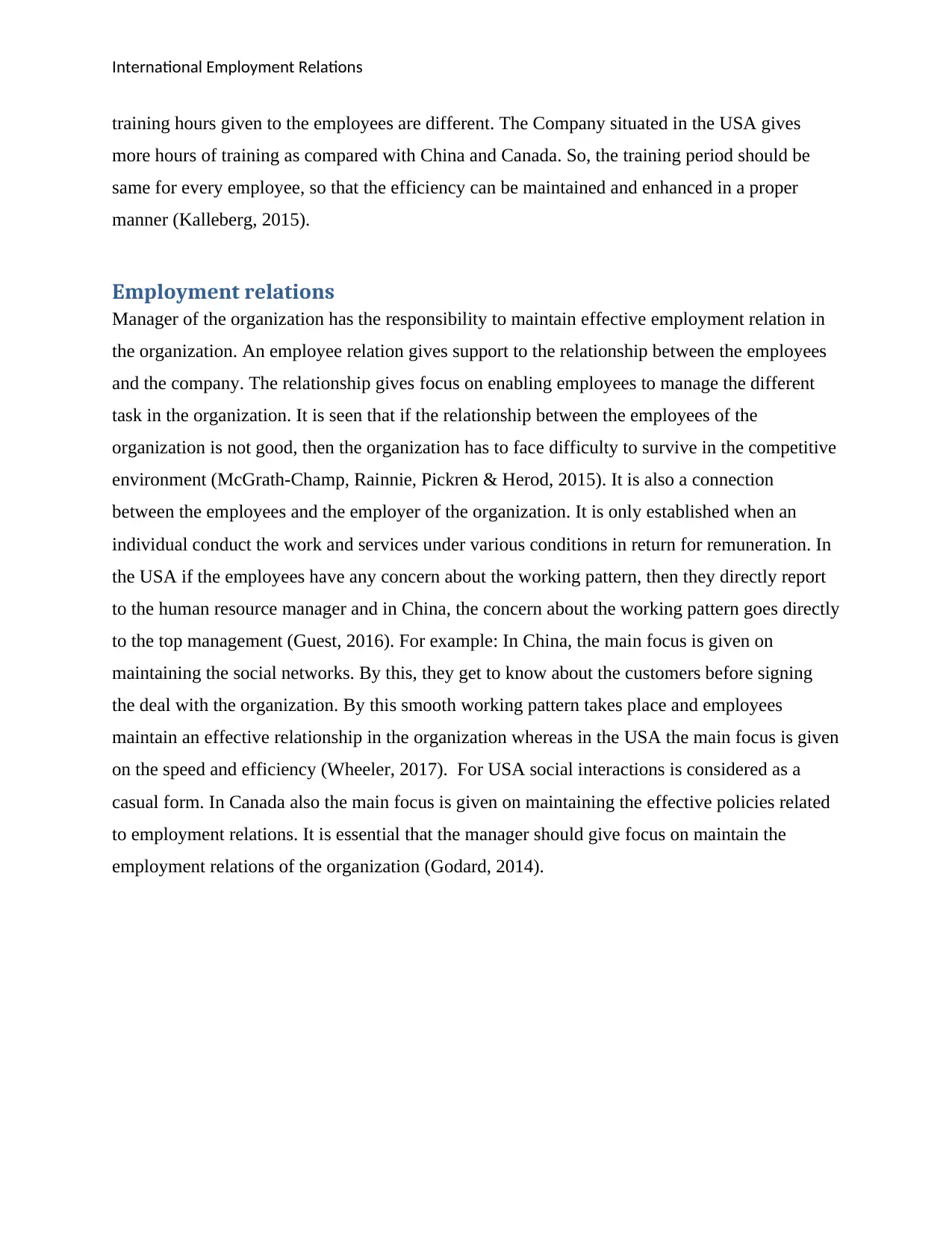
International Employment Relations
training hours given to the employees are different. The Company situated in the USA gives
more hours of training as compared with China and Canada. So, the training period should be
same for every employee, so that the efficiency can be maintained and enhanced in a proper
manner (Kalleberg, 2015).
Employment relations
Manager of the organization has the responsibility to maintain effective employment relation in
the organization. An employee relation gives support to the relationship between the employees
and the company. The relationship gives focus on enabling employees to manage the different
task in the organization. It is seen that if the relationship between the employees of the
organization is not good, then the organization has to face difficulty to survive in the competitive
environment (McGrath-Champ, Rainnie, Pickren & Herod, 2015). It is also a connection
between the employees and the employer of the organization. It is only established when an
individual conduct the work and services under various conditions in return for remuneration. In
the USA if the employees have any concern about the working pattern, then they directly report
to the human resource manager and in China, the concern about the working pattern goes directly
to the top management (Guest, 2016). For example: In China, the main focus is given on
maintaining the social networks. By this, they get to know about the customers before signing
the deal with the organization. By this smooth working pattern takes place and employees
maintain an effective relationship in the organization whereas in the USA the main focus is given
on the speed and efficiency (Wheeler, 2017). For USA social interactions is considered as a
casual form. In Canada also the main focus is given on maintaining the effective policies related
to employment relations. It is essential that the manager should give focus on maintain the
employment relations of the organization (Godard, 2014).
training hours given to the employees are different. The Company situated in the USA gives
more hours of training as compared with China and Canada. So, the training period should be
same for every employee, so that the efficiency can be maintained and enhanced in a proper
manner (Kalleberg, 2015).
Employment relations
Manager of the organization has the responsibility to maintain effective employment relation in
the organization. An employee relation gives support to the relationship between the employees
and the company. The relationship gives focus on enabling employees to manage the different
task in the organization. It is seen that if the relationship between the employees of the
organization is not good, then the organization has to face difficulty to survive in the competitive
environment (McGrath-Champ, Rainnie, Pickren & Herod, 2015). It is also a connection
between the employees and the employer of the organization. It is only established when an
individual conduct the work and services under various conditions in return for remuneration. In
the USA if the employees have any concern about the working pattern, then they directly report
to the human resource manager and in China, the concern about the working pattern goes directly
to the top management (Guest, 2016). For example: In China, the main focus is given on
maintaining the social networks. By this, they get to know about the customers before signing
the deal with the organization. By this smooth working pattern takes place and employees
maintain an effective relationship in the organization whereas in the USA the main focus is given
on the speed and efficiency (Wheeler, 2017). For USA social interactions is considered as a
casual form. In Canada also the main focus is given on maintaining the effective policies related
to employment relations. It is essential that the manager should give focus on maintain the
employment relations of the organization (Godard, 2014).
Paraphrase This Document
Need a fresh take? Get an instant paraphrase of this document with our AI Paraphraser
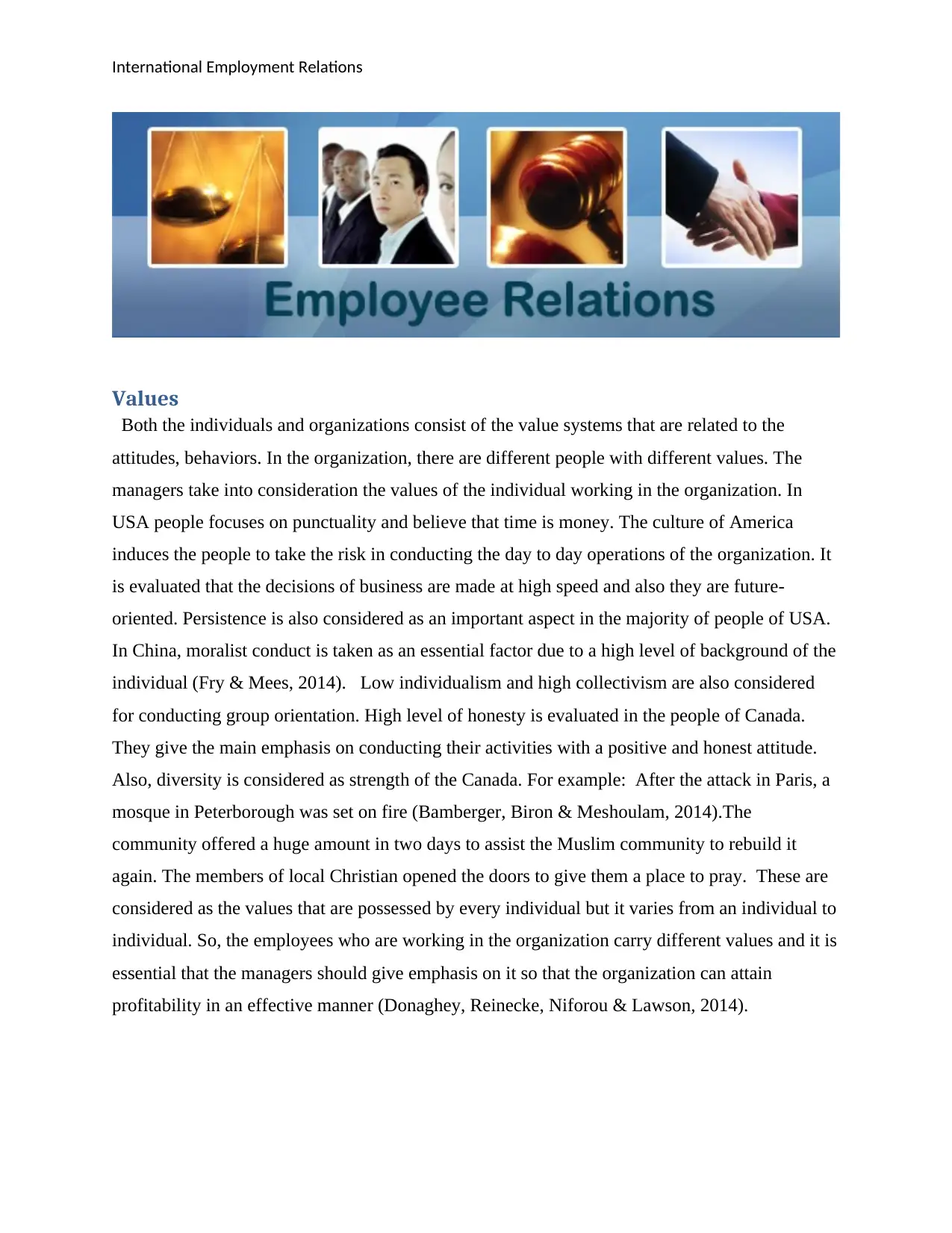
International Employment Relations
Values
Both the individuals and organizations consist of the value systems that are related to the
attitudes, behaviors. In the organization, there are different people with different values. The
managers take into consideration the values of the individual working in the organization. In
USA people focuses on punctuality and believe that time is money. The culture of America
induces the people to take the risk in conducting the day to day operations of the organization. It
is evaluated that the decisions of business are made at high speed and also they are future-
oriented. Persistence is also considered as an important aspect in the majority of people of USA.
In China, moralist conduct is taken as an essential factor due to a high level of background of the
individual (Fry & Mees, 2014). Low individualism and high collectivism are also considered
for conducting group orientation. High level of honesty is evaluated in the people of Canada.
They give the main emphasis on conducting their activities with a positive and honest attitude.
Also, diversity is considered as strength of the Canada. For example: After the attack in Paris, a
mosque in Peterborough was set on fire (Bamberger, Biron & Meshoulam, 2014).The
community offered a huge amount in two days to assist the Muslim community to rebuild it
again. The members of local Christian opened the doors to give them a place to pray. These are
considered as the values that are possessed by every individual but it varies from an individual to
individual. So, the employees who are working in the organization carry different values and it is
essential that the managers should give emphasis on it so that the organization can attain
profitability in an effective manner (Donaghey, Reinecke, Niforou & Lawson, 2014).
Values
Both the individuals and organizations consist of the value systems that are related to the
attitudes, behaviors. In the organization, there are different people with different values. The
managers take into consideration the values of the individual working in the organization. In
USA people focuses on punctuality and believe that time is money. The culture of America
induces the people to take the risk in conducting the day to day operations of the organization. It
is evaluated that the decisions of business are made at high speed and also they are future-
oriented. Persistence is also considered as an important aspect in the majority of people of USA.
In China, moralist conduct is taken as an essential factor due to a high level of background of the
individual (Fry & Mees, 2014). Low individualism and high collectivism are also considered
for conducting group orientation. High level of honesty is evaluated in the people of Canada.
They give the main emphasis on conducting their activities with a positive and honest attitude.
Also, diversity is considered as strength of the Canada. For example: After the attack in Paris, a
mosque in Peterborough was set on fire (Bamberger, Biron & Meshoulam, 2014).The
community offered a huge amount in two days to assist the Muslim community to rebuild it
again. The members of local Christian opened the doors to give them a place to pray. These are
considered as the values that are possessed by every individual but it varies from an individual to
individual. So, the employees who are working in the organization carry different values and it is
essential that the managers should give emphasis on it so that the organization can attain
profitability in an effective manner (Donaghey, Reinecke, Niforou & Lawson, 2014).
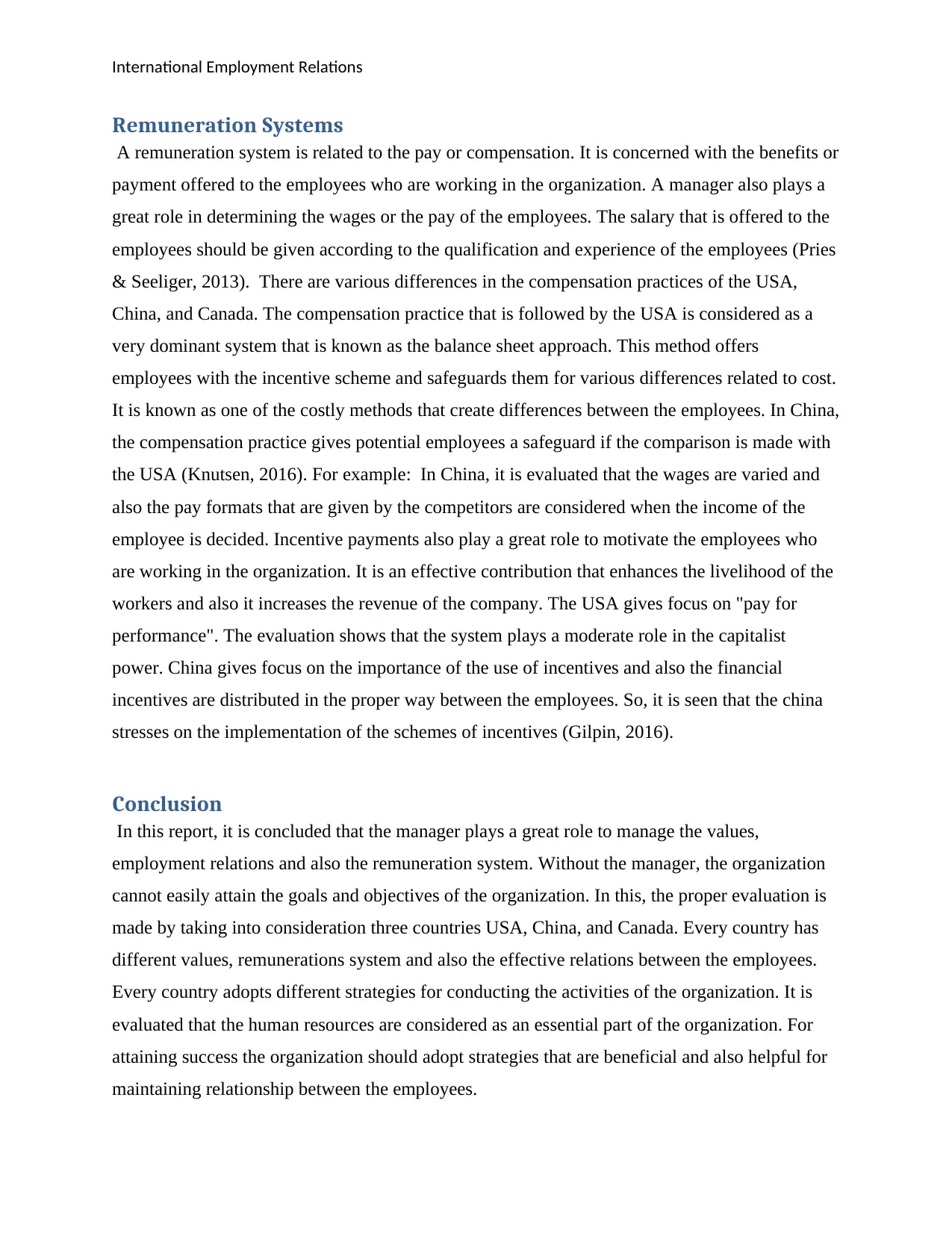
International Employment Relations
Remuneration Systems
A remuneration system is related to the pay or compensation. It is concerned with the benefits or
payment offered to the employees who are working in the organization. A manager also plays a
great role in determining the wages or the pay of the employees. The salary that is offered to the
employees should be given according to the qualification and experience of the employees (Pries
& Seeliger, 2013). There are various differences in the compensation practices of the USA,
China, and Canada. The compensation practice that is followed by the USA is considered as a
very dominant system that is known as the balance sheet approach. This method offers
employees with the incentive scheme and safeguards them for various differences related to cost.
It is known as one of the costly methods that create differences between the employees. In China,
the compensation practice gives potential employees a safeguard if the comparison is made with
the USA (Knutsen, 2016). For example: In China, it is evaluated that the wages are varied and
also the pay formats that are given by the competitors are considered when the income of the
employee is decided. Incentive payments also play a great role to motivate the employees who
are working in the organization. It is an effective contribution that enhances the livelihood of the
workers and also it increases the revenue of the company. The USA gives focus on "pay for
performance". The evaluation shows that the system plays a moderate role in the capitalist
power. China gives focus on the importance of the use of incentives and also the financial
incentives are distributed in the proper way between the employees. So, it is seen that the china
stresses on the implementation of the schemes of incentives (Gilpin, 2016).
Conclusion
In this report, it is concluded that the manager plays a great role to manage the values,
employment relations and also the remuneration system. Without the manager, the organization
cannot easily attain the goals and objectives of the organization. In this, the proper evaluation is
made by taking into consideration three countries USA, China, and Canada. Every country has
different values, remunerations system and also the effective relations between the employees.
Every country adopts different strategies for conducting the activities of the organization. It is
evaluated that the human resources are considered as an essential part of the organization. For
attaining success the organization should adopt strategies that are beneficial and also helpful for
maintaining relationship between the employees.
Remuneration Systems
A remuneration system is related to the pay or compensation. It is concerned with the benefits or
payment offered to the employees who are working in the organization. A manager also plays a
great role in determining the wages or the pay of the employees. The salary that is offered to the
employees should be given according to the qualification and experience of the employees (Pries
& Seeliger, 2013). There are various differences in the compensation practices of the USA,
China, and Canada. The compensation practice that is followed by the USA is considered as a
very dominant system that is known as the balance sheet approach. This method offers
employees with the incentive scheme and safeguards them for various differences related to cost.
It is known as one of the costly methods that create differences between the employees. In China,
the compensation practice gives potential employees a safeguard if the comparison is made with
the USA (Knutsen, 2016). For example: In China, it is evaluated that the wages are varied and
also the pay formats that are given by the competitors are considered when the income of the
employee is decided. Incentive payments also play a great role to motivate the employees who
are working in the organization. It is an effective contribution that enhances the livelihood of the
workers and also it increases the revenue of the company. The USA gives focus on "pay for
performance". The evaluation shows that the system plays a moderate role in the capitalist
power. China gives focus on the importance of the use of incentives and also the financial
incentives are distributed in the proper way between the employees. So, it is seen that the china
stresses on the implementation of the schemes of incentives (Gilpin, 2016).
Conclusion
In this report, it is concluded that the manager plays a great role to manage the values,
employment relations and also the remuneration system. Without the manager, the organization
cannot easily attain the goals and objectives of the organization. In this, the proper evaluation is
made by taking into consideration three countries USA, China, and Canada. Every country has
different values, remunerations system and also the effective relations between the employees.
Every country adopts different strategies for conducting the activities of the organization. It is
evaluated that the human resources are considered as an essential part of the organization. For
attaining success the organization should adopt strategies that are beneficial and also helpful for
maintaining relationship between the employees.
⊘ This is a preview!⊘
Do you want full access?
Subscribe today to unlock all pages.

Trusted by 1+ million students worldwide
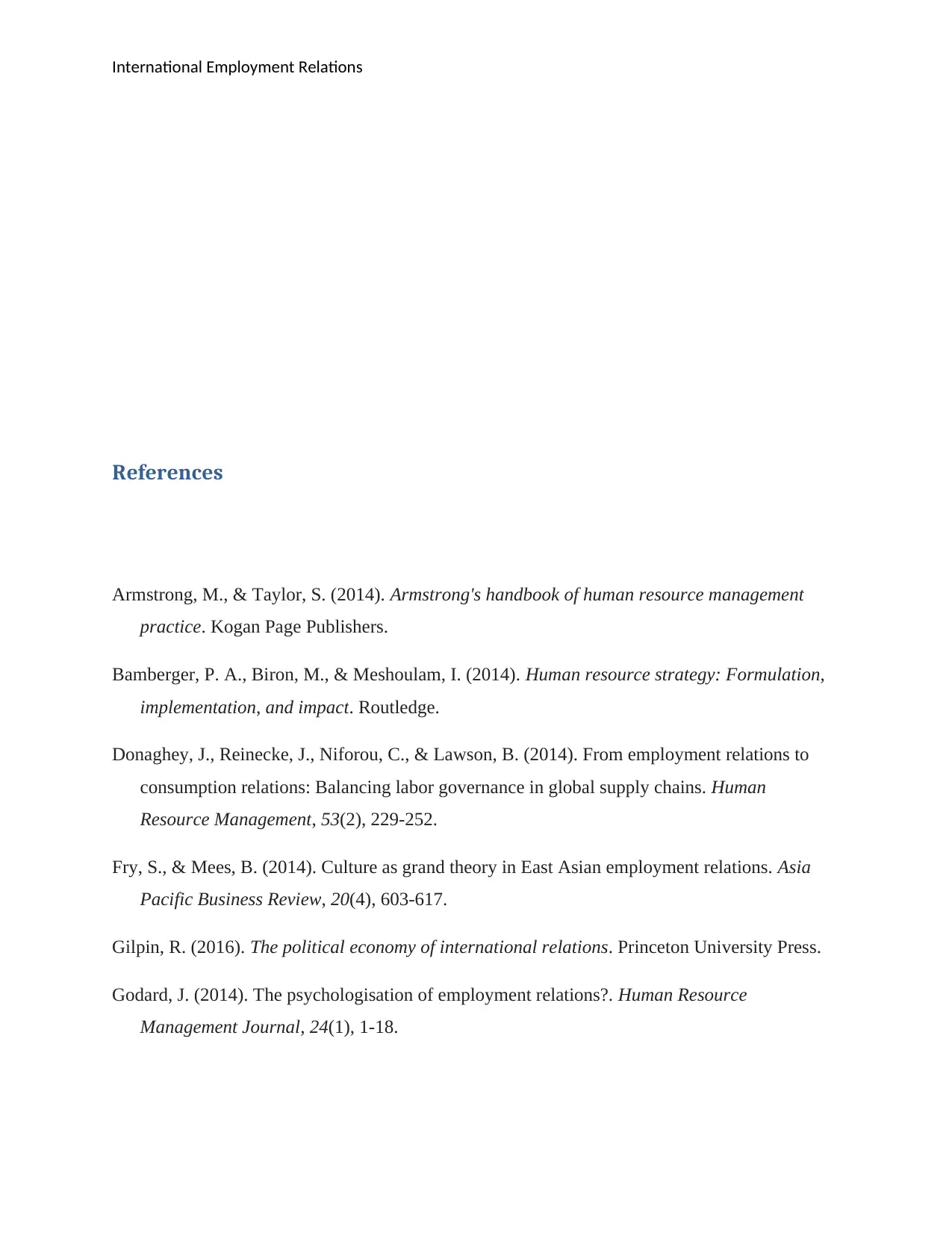
International Employment Relations
References
Armstrong, M., & Taylor, S. (2014). Armstrong's handbook of human resource management
practice. Kogan Page Publishers.
Bamberger, P. A., Biron, M., & Meshoulam, I. (2014). Human resource strategy: Formulation,
implementation, and impact. Routledge.
Donaghey, J., Reinecke, J., Niforou, C., & Lawson, B. (2014). From employment relations to
consumption relations: Balancing labor governance in global supply chains. Human
Resource Management, 53(2), 229-252.
Fry, S., & Mees, B. (2014). Culture as grand theory in East Asian employment relations. Asia
Pacific Business Review, 20(4), 603-617.
Gilpin, R. (2016). The political economy of international relations. Princeton University Press.
Godard, J. (2014). The psychologisation of employment relations?. Human Resource
Management Journal, 24(1), 1-18.
References
Armstrong, M., & Taylor, S. (2014). Armstrong's handbook of human resource management
practice. Kogan Page Publishers.
Bamberger, P. A., Biron, M., & Meshoulam, I. (2014). Human resource strategy: Formulation,
implementation, and impact. Routledge.
Donaghey, J., Reinecke, J., Niforou, C., & Lawson, B. (2014). From employment relations to
consumption relations: Balancing labor governance in global supply chains. Human
Resource Management, 53(2), 229-252.
Fry, S., & Mees, B. (2014). Culture as grand theory in East Asian employment relations. Asia
Pacific Business Review, 20(4), 603-617.
Gilpin, R. (2016). The political economy of international relations. Princeton University Press.
Godard, J. (2014). The psychologisation of employment relations?. Human Resource
Management Journal, 24(1), 1-18.
Paraphrase This Document
Need a fresh take? Get an instant paraphrase of this document with our AI Paraphraser
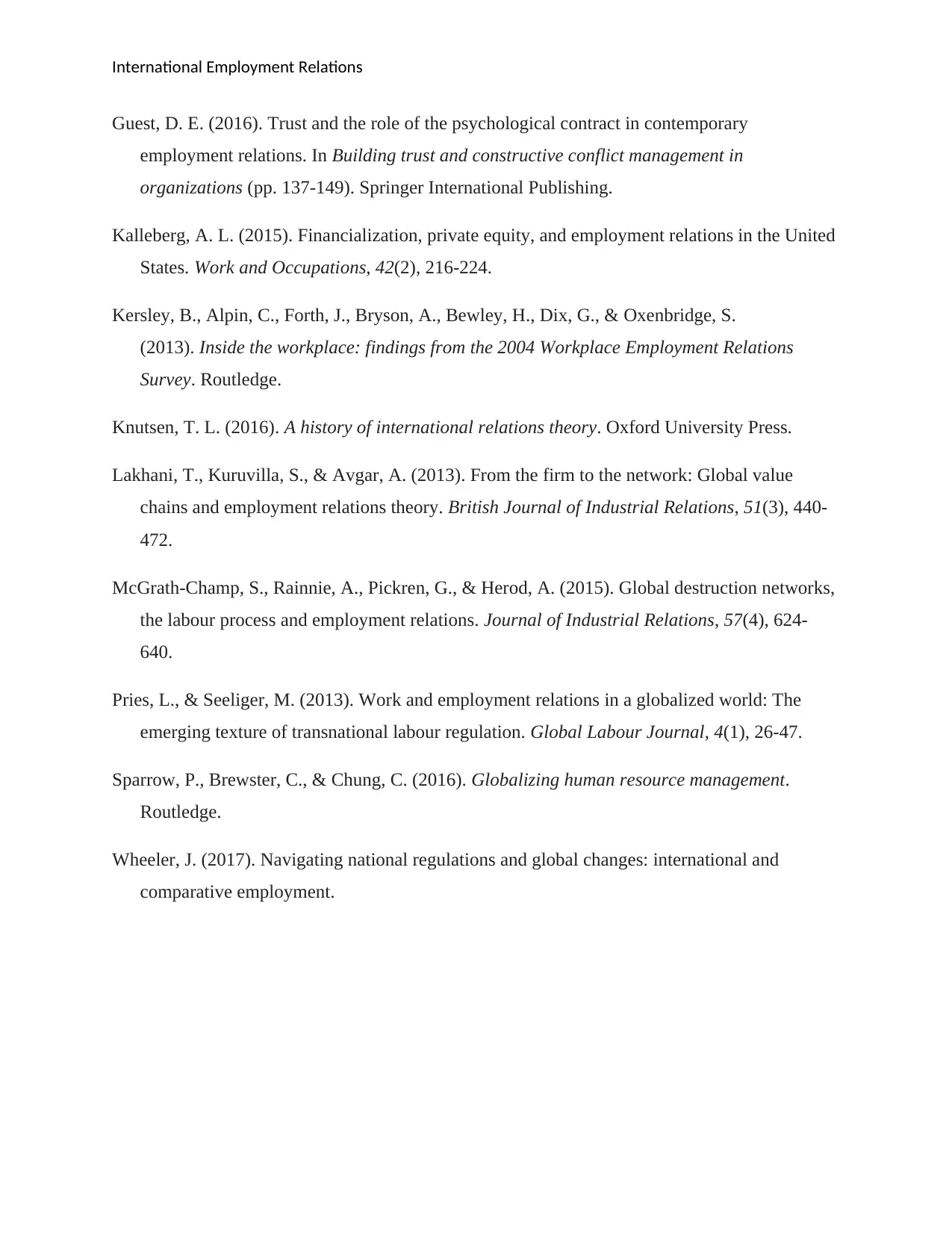
International Employment Relations
Guest, D. E. (2016). Trust and the role of the psychological contract in contemporary
employment relations. In Building trust and constructive conflict management in
organizations (pp. 137-149). Springer International Publishing.
Kalleberg, A. L. (2015). Financialization, private equity, and employment relations in the United
States. Work and Occupations, 42(2), 216-224.
Kersley, B., Alpin, C., Forth, J., Bryson, A., Bewley, H., Dix, G., & Oxenbridge, S.
(2013). Inside the workplace: findings from the 2004 Workplace Employment Relations
Survey. Routledge.
Knutsen, T. L. (2016). A history of international relations theory. Oxford University Press.
Lakhani, T., Kuruvilla, S., & Avgar, A. (2013). From the firm to the network: Global value
chains and employment relations theory. British Journal of Industrial Relations, 51(3), 440-
472.
McGrath-Champ, S., Rainnie, A., Pickren, G., & Herod, A. (2015). Global destruction networks,
the labour process and employment relations. Journal of Industrial Relations, 57(4), 624-
640.
Pries, L., & Seeliger, M. (2013). Work and employment relations in a globalized world: The
emerging texture of transnational labour regulation. Global Labour Journal, 4(1), 26-47.
Sparrow, P., Brewster, C., & Chung, C. (2016). Globalizing human resource management.
Routledge.
Wheeler, J. (2017). Navigating national regulations and global changes: international and
comparative employment.
Guest, D. E. (2016). Trust and the role of the psychological contract in contemporary
employment relations. In Building trust and constructive conflict management in
organizations (pp. 137-149). Springer International Publishing.
Kalleberg, A. L. (2015). Financialization, private equity, and employment relations in the United
States. Work and Occupations, 42(2), 216-224.
Kersley, B., Alpin, C., Forth, J., Bryson, A., Bewley, H., Dix, G., & Oxenbridge, S.
(2013). Inside the workplace: findings from the 2004 Workplace Employment Relations
Survey. Routledge.
Knutsen, T. L. (2016). A history of international relations theory. Oxford University Press.
Lakhani, T., Kuruvilla, S., & Avgar, A. (2013). From the firm to the network: Global value
chains and employment relations theory. British Journal of Industrial Relations, 51(3), 440-
472.
McGrath-Champ, S., Rainnie, A., Pickren, G., & Herod, A. (2015). Global destruction networks,
the labour process and employment relations. Journal of Industrial Relations, 57(4), 624-
640.
Pries, L., & Seeliger, M. (2013). Work and employment relations in a globalized world: The
emerging texture of transnational labour regulation. Global Labour Journal, 4(1), 26-47.
Sparrow, P., Brewster, C., & Chung, C. (2016). Globalizing human resource management.
Routledge.
Wheeler, J. (2017). Navigating national regulations and global changes: international and
comparative employment.
1 out of 8
Related Documents
Your All-in-One AI-Powered Toolkit for Academic Success.
+13062052269
info@desklib.com
Available 24*7 on WhatsApp / Email
![[object Object]](/_next/static/media/star-bottom.7253800d.svg)
Unlock your academic potential
Copyright © 2020–2025 A2Z Services. All Rights Reserved. Developed and managed by ZUCOL.





